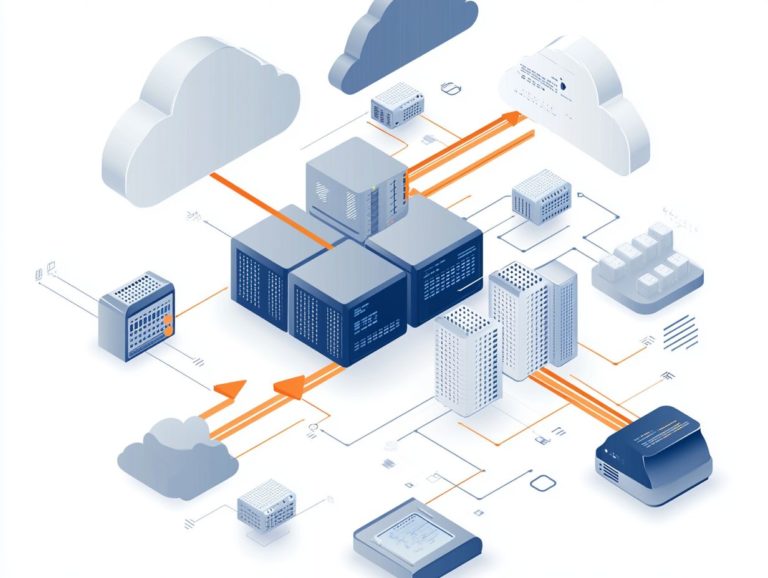How IaaS Affects IT Budgets
In today’s fast-paced digital landscape, grasping the concept of Infrastructure as a Service (IaaS) is crucial for your business if you’re looking to optimize your IT budget. This exploration delves into the many benefits of IaaS, from significant cost savings to remarkable scalability. It also evaluates its effects on both big upfront costs and ongoing expenses.
As you consider adopting IaaS, it’s essential to assess your specific needs and choose the right provider that aligns with your objectives. Uncover best practices for managing your IT budget effectively within an IaaS framework and unlock the powerful benefits that IaaS offers for your IT strategy.
Contents
Key Takeaways:

IaaS brings significant cost savings to IT budgets by reducing capital expenditures and providing predictable operating expenses. With its scalability and flexibility, IaaS allows organizations to adjust their IT budgets based on their changing needs. To optimize your spending, consider how to manage IaaS costs effectively. Before adopting IaaS, it’s important to assess your organization’s specific needs and choose the right provider to ensure the best budget management practices.
Understanding IaaS: Your Cloud Solution
Infrastructure as a Service (IaaS) is your gateway to a cloud-based service model that delivers virtualized computing resources right over the internet. You can access and manage your IT infrastructure without the hassle of physical hardware.
Leading providers like Amazon Web Services (AWS), Microsoft Azure, IBM Cloud, and Google Cloud Platform support various business functions and streamline your IT management to drive operational efficiency. Essential components such as virtual machines, networking capabilities, and storage solutions enhance your organizational agility.
- Virtual machines allow you to run applications seamlessly, while sophisticated networking tools ensure secure and flexible connectivity between your resources.
- Diverse storage options enable you to dynamically scale your data needs, accommodating fluctuating workloads with ease.
As you navigate the growing technology challenges of infrastructure scalability, deployment speed, and cost efficiency, leveraging IaaS becomes increasingly advantageous. This model not only reduces your capital expenses by cutting investments in physical hardware but also equips you with the scalability needed to adapt to changing demands. Ultimately, it fosters innovation and gives you a competitive edge.
Benefits of IaaS
IaaS offers exciting cost-saving opportunities that can redefine your organization s approach to IT management. It provides flexible scalability, quicker time to market, performance enhancement, and security improvements.
Embracing a growth mindset allows you to harness the full potential of IaaS, ensuring your organization can seamlessly adapt to evolving demands. This approach also enables you to elevate customer experiences with the increased support offered by cloud vendors.
Cost Savings
One of the standout benefits of IaaS is the remarkable cost savings it brings to your organization. It transforms capital expenses into predictable operating expenses, enhancing your IT budget and total cost of ownership.
This shift enables you to optimize your expense management and reallocate financial resources toward growth initiatives. By embracing IaaS solutions, you can eliminate the burden of substantial investments in physical servers and data center infrastructure, which often come with hefty maintenance and upgrade costs.
For example, a retail giant that adopted the IaaS model successfully scaled its IT resources to meet seasonal demand fluctuations without the headache of over-provisioning. Similarly, a healthcare organization effectively leveraged IaaS to enhance its data storage capabilities while maintaining regulatory compliance, resulting in significant operational efficiencies.
Such flexible and scalable solutions allow you to concentrate on core activities, driving innovation and securing a competitive edge. Dive into IaaS today and revolutionize your IT strategy!
Scalability and Flexibility
Flexible scalability is a defining feature of Infrastructure as a Service (IaaS), enabling you to adjust your computing resources based on demand. This not only reduces infrastructure costs but also enhances operational efficiency.
By embracing cloud solutions, you can swiftly respond to market fluctuations, ensuring a quicker time to market and greater support for your evolving needs.
For example, during peak business seasons, your retail company might require a rapid increase in server capacity to accommodate the surge in online traffic. Conversely, once the holiday rush subsides, it s just as easy to scale down your resources, sidestepping unnecessary expenses.
This adaptability also benefits startups launching new products. They can deploy only what they need at first, and as their user base expands, they can scale resources seamlessly.
Thanks to IaaS s array of automated tools and dashboards, you can monitor and adjust resources in real-time. This ensures optimal resource utilization without sacrificing performance.
Impact of IaaS on IT Budgets

The impact of IaaS on your IT budget is profound. It primarily reduces upfront costs and establishes predictable operating expenses, making it essential to know how to plan your IaaS budget to elevate your financial planning.
Transitioning to IaaS will revolutionize your IT costs, opening doors to innovation and business growth. This shift enhances financial flexibility and positions your organization to thrive in a competitive landscape.
Reducing Upfront Costs
IaaS can significantly reduce your upfront costs by allowing you to sidestep the hefty expenses of maintaining physical IT infrastructure. This often complicates financial planning and technology investments.
For example, a mid-sized company that made the leap to IaaS reported a remarkable 40% decrease in IT spending within just the first year. By eliminating the need to buy expensive servers and trimming the budget for ongoing maintenance, they transitioned to a pay-as-you-go model that offers unparalleled flexibility and scalability.
Consider a startup that capitalized on IaaS to swiftly deploy its applications. This approach allowed them to dynamically scale resources based on real-time demand. The agility afforded by IaaS not only slashed their upfront costs but also freed up funds for product development and marketing efforts, ultimately fueling innovation and driving growth.
Predictable Operating Expenses
The shift to IaaS enables you to establish predictable operating expenses, which are essential for effective IT budget management. To better understand this transition, consider the differences highlighted in IaaS vs. traditional IT infrastructure. This predictability helps mitigate financial risks.
For instance, a mid-sized e-commerce company adopted an IaaS platform to handle its fluctuating bandwidth needs during peak shopping seasons. By leveraging IaaS, they scaled resources according to demand, ensuring they only paid for what they used. This approach provided financial clarity and safeguarded them against unexpected spikes in operating costs.
Another noteworthy example involves a healthcare organization that transitioned to an IaaS provider for data storage and analytics. This strategic move significantly reduced their capital expenses and allowed for more accurate forecasting. This facilitated better financial decisions.
These real-world applications highlight how IaaS can streamline your expense management. You can allocate your budgets with greater effectiveness.
Consideraciones antes de adoptar IaaS
Before adopting IaaS, it’s essential to thoughtfully consider several key factors.
Begin by assessing your unique needs, then evaluate the various IaaS providers available. Don’t overlook potential technology challenges, including compliance enforcement and security requirements.
By conducting a thorough analysis, you can ensure that your cloud strategies align perfectly with your organizational goals and risk mitigation plans.
Assessing the Needs of Your Organization
Assessing the needs of your organization is a pivotal step in determining whether Infrastructure as a Service (IaaS) is the right cloud-based service for you. This aligns seamlessly with your aspirations for growth and operational efficiency.
A thorough understanding of your current IT infrastructure and future growth projections will significantly enhance your decision-making process.
To effectively evaluate the suitability of IaaS for your organization, consider several key factors. Start by assessing your existing infrastructure to identify any gaps or inefficiencies that could hinder performance.
Next, analyze your specific performance needs think computing power, storage, and network capabilities while keeping peak usage periods in mind.
Look at how fast your business might grow. This can unveil how swiftly evolving business demands might influence your resource allocation and costs.
By conducting this comprehensive assessment, you’ll enable your organization to make informed choices that support scalability and ensure reliability in a cloud environment.
Choosing the Right IaaS Provider

Choosing the right IaaS provider is crucial for ensuring that your organization’s cloud strategy achieves optimal performance, security, and compliance enforcement. When considering cloud vendors like Amazon Web Services (AWS), Microsoft Azure, and Google Cloud Platform, each brings unique strengths that cater to diverse business needs.
As you evaluate potential providers, it’s wise to look into their reputation within the industry and assess their reliability and customer support track record. Don t overlook the breadth of their service offerings think scalability, storage options, and compliance with essential regulatory frameworks like GDPR or HIPAA.
Performance metrics, such as uptime guarantees and response times, are key factors in determining how effectively the provider can meet your operational demands.
You should also look closely at their security measures, like data encryption and multi-factor authentication, to ensure that your sensitive information remains safeguarded against potential threats.
Don’t wait! Start comparing providers now to find the perfect fit for your organization!
Best Practices for Managing IT Budgets with IaaS
Want to manage your IT budget better? Using best practices with IaaS can really help! Implementing these strategies can elevate your expense management and optimize resource allocation.
By closely monitoring usage and employing effective cost optimization strategies, you can make informed decisions that align perfectly with your financial objectives and operational goals.
Monitoring and Adjusting Usage
Monitoring and adjusting usage in an IaaS environment is essential for maximizing operational efficiency and achieving significant cost savings. This directly impacts your IT expenses.
By regularly reviewing resource utilization, you can pinpoint underutilized resources and optimize your cloud spending effectively.
Utilizing advanced analytics and cloud management tools provides you with a deeper understanding of consumption patterns and aids in proactive decision-making.
With dashboards that visualize key metrics, you can easily grasp the overall health of your infrastructure. This makes it simpler for stakeholders to stay informed.
Integrating automated alerts ensures that any anomalies in resource usage are recognized swiftly. This allows you and your team to address issues without delay.
This data-driven approach not only helps minimize waste but also enables you to allocate resources strategically based on real-time demand. Ultimately, this leads to improved financial planning and governance.
Maximize Your Savings with Cost Optimization Strategies
Cost optimization strategies are essential for controlling expenses in an IaaS framework. They help reduce the risks of unexpected IT costs.
You can employ various strategies, such as:
- Rightsizing resources
- Leveraging reserved instances
- Optimizing data storage solutions
These practices ensure you re only paying for what you need. Rightsizing means adjusting resources based on actual use.
Reserved instances can offer significant discounts for long-term commitments. Optimizing storage helps you choose the right type based on how often you access data.
These strategies streamline expenses and boost efficiency. You can then invest those savings in innovation and growth!
Frequently Asked Questions
What is IaaS?

IaaS stands for Infrastructure as a Service. It s a way to access IT resources like servers and storage over the internet without buying hardware.
How does IaaS affect IT budgets?
IaaS can significantly impact IT budgets by offering a more cost-effective solution for infrastructure needs. It eliminates expensive hardware and maintenance costs, making it a more affordable option for businesses. To maximize these benefits, it’s crucial to understand how to align IT budgeting with cloud costs.
What are the main cost considerations when using IaaS?
The main cost considerations for using IaaS include the service cost, data transfer and storage fees, and any additional features or support needed. It’s essential to evaluate these costs carefully to ensure that IaaS is the right option for your business.
Can IaaS help reduce overall IT costs?
Yes, IaaS can really help cut your overall IT costs by eliminating the need to purchase and maintain hardware and software. It also offers a pay-per-use model, allowing businesses to only pay for the resources they need, reducing wasted expenses.
What are the potential drawbacks of using IaaS?
Some potential drawbacks of using IaaS include the risk of security breaches, reliance on a third-party provider for critical infrastructure, and possible hidden costs. It’s crucial to thoroughly research and consider these factors before implementing IaaS.
Are there any long-term cost benefits of using IaaS?
Yes, there can be long-term cost benefits of using IaaS. By utilizing a cloud-based infrastructure, businesses can scale resources as needed, eliminating overprovisioning and reducing waste. Furthermore, businesses can reduce hardware and software upgrade costs, saving money in the long run.






